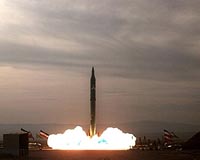| . |  |
. |
London (AFP) May 10, 2010 Iran could target western Europe with missiles by 2014, although it would take at least twice as long before they could hit the United States, experts said in a report published Monday. Tehran is more than a decade away from developing a missile capable of reaching the US east coast, the International Institute for Strategic Studies (IISS) said in a report on Iran's ballistic missile capabilities. The London-based group said Iran was making "robust strides" in developing ballistic missiles "in tandem" with its efforts to expand its nuclear capabilities. "The two programmes appear to be connected, with the aim of giving Iran the capability to deliver nuclear warheads well beyond its borders," it said. Iran's ballistic missiles could be used to wage a terror campaign in the Middle East, it added, although its missiles are at present too inaccurate to shut down another country's critical military activities. While Iran has been alongside North Korea in developing missile capabilities, Tehran has now surpassed Pyongyang in terms of technical ability, the IISS experts said. The United States and Europe have long accused Iran of seeking to develop nuclear weapons under the guise of its civilian nuclear energy programme, a charge Tehran denies. "Flight test programmes for solid-propellant missiles historically take on average more than four years," the report said. "To achieve a reasonable measure of reliability and confidence, a dozen or more test flights should be conducted. "Therefore, Iran is not likely to field a liquid-fuelled missile capable of targeting western Europe before 2014 or 2015." The "worst-case scenario" projected at the turn of the century about Iran being able to strike the United States within five years has not materialised, the study said. However, "logic and the history of Iran's evolutionary missile and space-launcher development efforts suggest that Tehran would develop and field an intermediate-range missile before embarking on a programme to develop an intercontinental ballistic missile (ICBM) capable of reaching the American east coast, 9,000 kilometres away. "It is thus reasonable to conclude that a notional ICBM... is more than a decade away in development." Iran's space programme launches have been "proof-of-principle demonstrations", offering no immediate strategic value beyond symbolism, said the report. The IISS estimated that Iran has around 200 to 300 Shahab-1 and -2 missiles capable of reaching targets in neighbouring countries. "Iran's ballistic missiles could be used as a political weapon to wage a terror campaign against adversary cities," primarily in the Middle East, the report said. "While such attacks might trigger fear, the expected casualties would be low -- probably less than a few hundred, even assuming Iran unleashed its entire ballistic missile arsenal and that a majority of the warheads penetrated missile defences. "The military utility of Iran's ballistic missiles is severely limited because of their very poor accuracy. "The missiles would probably be incapable of shutting down critical military activities."
Share This Article With Planet Earth
Related Links Learn about nuclear weapons doctrine and defense at SpaceWar.com Learn about missile defense at SpaceWar.com All about missiles at SpaceWar.com Learn about the Superpowers of the 21st Century at SpaceWar.com
 Report: Iran may soon have U.S. in range
Report: Iran may soon have U.S. in rangeWashington (UPI) Apr 21, 2010 An unclassified U.S. Defense Department report says that Iran may build missiles capable of striking the United States by 2015. "With sufficient foreign assistance, Iran could probably develop and test an intercontinental ballistic missile capable of reaching the United States by 2015," said the report, leaked to national media and reported by Israel's Arutz Sheva news agency. Th ... read more |
|
| The content herein, unless otherwise known to be public domain, are Copyright 1995-2010 - SpaceDaily. AFP and UPI Wire Stories are copyright Agence France-Presse and United Press International. ESA Portal Reports are copyright European Space Agency. All NASA sourced material is public domain. Additional copyrights may apply in whole or part to other bona fide parties. Advertising does not imply endorsement,agreement or approval of any opinions, statements or information provided by SpaceDaily on any Web page published or hosted by SpaceDaily. Privacy Statement |